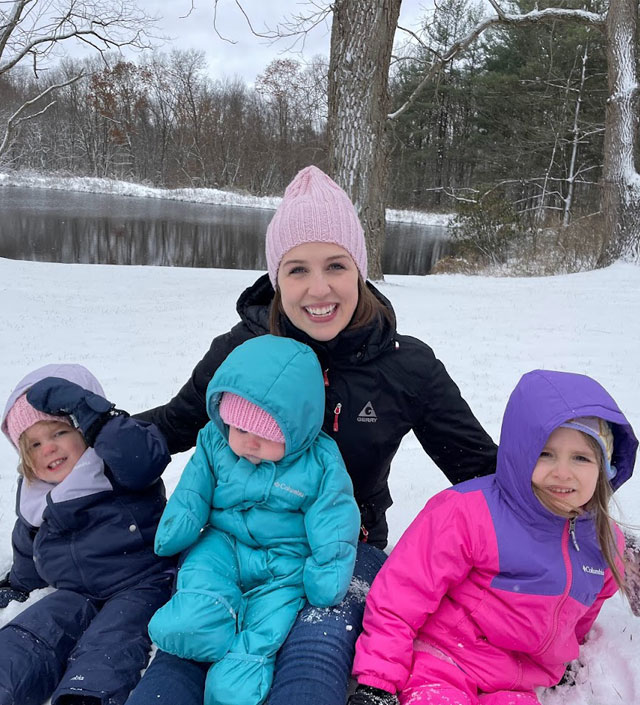Vestia’s new CEO, Lauren Oschman, likens her career path to Purl, the pink ball of yarn in the Pixar animated short feature “Purl” who knits her threads into a black suit to fit in at her new job at a male-centric financial start-up, then learns she’s repressing what she truly is.
Oschman, 33, began her career as the only enduring woman among more than 50 financial advisors at a firm specializing in physician clients. Like Purl, she found she could make herself to fit in, but she wasn’t using her unique yarns for her destiny.
And she, too, wasn’t loving the toxic male climate when she had her Purl epiphany.
“I wanted to be an owner of a place where I would be proud for my daughters to work,” said the mother of three girls 5 and younger.
So Oschman and several colleagues left the firm four years ago to found Vestia Personal Wealth Advisors of Nashville, Tenn., which boasts a collective 150 years’ experience investing for physicians.
Oschman was elevated to chief executive officer last month after fellow founding partner Tommy Martin decided to branch off full-time in his own venture-capital firm in the healthcare niche. Oschman’s title had been chief experience officer.
“Lauren’s ascent to the CEO role has been eagerly anticipated by all of us at Vestia and was never a question of ‘if’ but simply ‘when,’” Martin said.
“Niches Within Niches”
Almost as soon as Vestia opened for physicians in January 2018, it started organically organizing into practice groups, “niches within niches,” Oschman said.
By 2020, Oschman realized her dream of a Women in Medicine practice group, which she and a colleague started with their existing clients.
“We found we were talking to female physicians differently than others,” Oschman said.
Most women need confidence boosting to advocate for themselves and negotiate maternity and family leaves, for example. Many also want contracts that ensure family time and favor investments that align with their values.
“We found an advantage for female advisors to work with female physicians. We lean into that,” Oschman said.
“Similarly, we have specialists who work only with orthopedic surgeons,” she said. Vestia is considering more groups for military physicians, urologists and anesthesiologists.
Vestia’s orthopedic surgeons group, launched last year, has turned out to be even more successful than the women physicians group, Oschman said.
To illustrate why, Oschman recalled a seminar host relating a tale about a retiree conference led by four panelists. Three were financial advisors who described themselves as generalists, serving all comers. The fourth identified herself as working only with retirees with a net worth of at least $2 million who wanted to travel the world — criteria met by only three people in the room.
After the session, no one came up to speak with the generalists, who left empty-handed. The fourth financial advisor was approached by all three high-asset retirees and left with referral data for all three.
The American Association of Orthopedic Surgeons tallied 29,613 orthopedic surgeons in its 2018 survey. Although women constitute about 51% of the U.S. population and 49% of the total workforce, only about 6 percent of orthopedic surgeons were women, the AAOS found.
About 90% of Vestia’s 500 client households are physicians, and some are multi-doctor households, Oschman said. The rest come from referrals, mostly in the medical space. Average client income is $500,000 to $600,000 a year, and average client assets to invest are about $1 million, she said.
Lab Coats in Her Blood
As the daughter of a cardiologist, Oschman grew up understanding the obstacles doctors face in planning careers and retirement.
For one, physicians all suffer early years of pitiful income and debt. Their canned tuna-macaroni casserole sustenance catapults to 10x earnings overnight, but not until they’re well into their 30s.
Doctors come saddled with about $250,000 in student-loan debt, she said. All doctors have to buy malpractice and liability insurance. Personal disability insurance is a must-have. Imagine investing in a career as a surgeon, then suffering an accident or illness that disables the hands.
Many doctors have mortgages for commercial practices as well as their homes. Then there are doctors, including orthopedic surgeons, who commonly invest vertically as part-owners of the surgery centers and other medical businesses they use.
Still, it’s never a one-size-fits-all, Oschman said.
Two families may have the same debt and similar income, but one will lay awake at night worrying about student loans while the other sees the loans as investments that will take care of themselves by following the plan, she said.
“The first step is always the values meeting, which is incredibly effective to not just find out the dollars and cents but also how they feel about the various components of their financial life,” Oschman said. “Some people want to pay off their student loans before they focus on investment, while others say they trust you to find the most effective way.”
Some have other needs and goals, too; for example, kids in private school or elders in nursing care.
Staying Up on the News
Advising physicians means keeping up with intricate details about clients’ finances.
Last fall, when the Biden administration announced its overhaul of the federal Public Service Loan Forgiveness program, many of Oschman’s clients immediately became eligible for forgiveness of a good chunk of their student debt.
The new U.S. Department of Education policies made it easier to apply their years of work at hospitals, where most doctors start in their first five to 10 years, as public service, because almost all hospitals are nonprofits. The recalculation for past payments that were newly forgiven shaved years off many clients’ loans,
For one thoracic surgeon that Oschman recently worked with, that translated to a savings of a few hundred dollars a month — money the surgeon could apply toward investments to help him reach his retirement goals sooner, she said.
“So, this is something we’re coming back to, for people who’ve had an established relationship with us,” Oschman said.
Another client’s loan charged only 2% interest, but paying off the loan had been a weight that was important for the client to get off her shoulders. “I emailed her a ‘thinking about you and your loans and the new policy announcement,’ and Zoomed the client,” Oschman said. She advised the client on the application process, and as a result, the client now has closed all of her student debt, to her great relief.
Designing Fees
Vestia’s structure is designed for intensely personal and specialized services, so fees may be above industry averages, Oschman said.
“We haven’t done anything brand new in building a fee structure that makes the most sense for doctors,” she said, but, “we do a lot of work, because our clients are busy people, and our expertise is particularly relevant.”
Most ongoing clients choose the collaborative option, which retains a personal financial advisor for about $500 to $1,000 per month. Doctors needing less intensive care may choose Vestia’s hourly fee option, which ranges from $100 to $500 per hour, depending on the expert called upon, she said.
Clients choosing the collaborative option get a personal advisor who keeps an individualized service calendar to remind each client of what needs to be done and when to fulfill their plan.
“We do a lot of work, because our clients are very, very busy … and have so many priorities tugging at their time,” Oschman said. “Doctors don’t have dedicated time to spend on financial planning.”
Unlike firms that just set up investment plans, Vestia’s advisors help their clients throughout their financial streams, such as sending comparative data to ensure they know their worth before going into contract negotiations and shopping for physician-only mortgage deals, according to Oschman. They work up asset-protection strategies, because just about every doctor gets sued, sooner or later.
Vestia has expert negotiators on retainer to work better contracts for clients as needed. One negotiation garnered an extra $250,000 per year on the employment contract for a cardiologist brought on board to build a new program. Vestia’s on-call negotiator earned a commission, separate from ongoing services or other standalone fees, according to Oschman.
Standalone fees range from $4,000 to $12,000 for one-time services, such as the debt repayment plan, the initial financial investment plan and the new-client fee, according to Oschman.
And Then Came Covid
Physicians’ recovery from the Covid-19 crisis is an “evolving conversation,” Oschman said.
“Covid has been really tough on a lot of physicians,” she said. “Even if they aren’t on the frontline treating patients, they’re surgeons who were unable to operate for months because of the shutdown.”
Most hospitals and surgical centers closed for elective procedures for months when global public health authorities declared a world pandemic in March 2020. In the U.S., the federal and state governments took emergency measures to prioritize saving lives from the novel virus that popped up with no known cure, while all hands were on deck to develop treatments and vaccines. Despite extraordinary efforts, Covid has claimed more than 1 million lives in the U.S.
Covid has also accelerated doctor burnout. Oschman said doctors are asking her how they can make better use of their resources to achieve financial independence sooner than planned before Covid.
“Before Covid, the biggest pain point for a lot of established doctors was electronic medical records systems that would upend the way they ran their clinics,” Oschman said. “I would tell them they need to plan so they can retire because they want to, not because they have to” or else adapt to whole new systems.
In contrast, she said, the game-changing federal Affordable Care Act that went into effect in 2014 had virtually no impact on doctors’ earnings or ability to save, despite all the political agitation about “Obamacare.” That undue panic did prompt some doctors to think more widely about the kinds of changes that could affect their financial resiliency, she said.
And then came Covid.
“If you were financially independent before Covid hit, you could walk away,” she said. For some who were nearing retirement but not independent yet, Covid added some years of work before they can retire to make up for their lost time.
Never Too Late for Good Advice
Women comprise about 60% of Vestia’s 21-member team, including partners and employees. The independent advisory firm manages more than $500 million in assets now and hopes to grow to a billion-dollar firm, according to Vestia.
And while the average age of a new client is about 40, Oschman guessed, her women physicians’ group welcomed a new client last week who’s 70 and retired at 65.
Oschman remembered she knew a cardiologist who wasn’t a client who had made bad investment decisions. He had to sign a seven-year contract with a hospital at age 70, because he couldn’t afford to retire, she said.
“It’s grueling work to be a physician … and seeing that physician was a driving force for me. I wondered how that must have felt,” Oschman said, admitting she couldn’t help but envision her cardiologist father.
And, yes, Oschman’s dad is her client, she said.
Linda Hildebrand is a longtime newspaper editor and consumer-action reporter.







